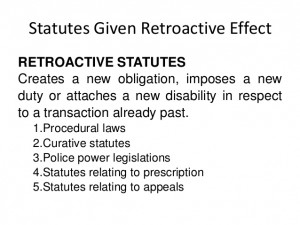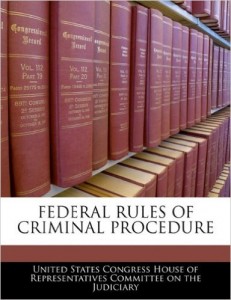Welch v United States
The United States Supreme Court
Decided: April 18th, 2016
578 U.S _____(2016)
Issue: Whether Johnson is a substantive decision with retroactive effect in cases on collateral review. ?Johnson considered the residual clause of the Armed Career Criminal Act of 1984, 18 U. S. C. 924(e)(2)(B)(ii). There the Court held that provision void for vagueness. The present case asks whether Johnson is a substantive decision that is retroactive in cases on collateral review.
Facts: Petitioner Welch was sentenced under the Armed Career Criminal Act before Johnson was decided. On direct view, the Eleventh Circuit affirmed his sentence, holding that Welchs prior Florida conviction for robbery qualified as a violent felony under the residual clause. After his conviction became final, Welch sought collateral review relief under 28 U.S.C 2255, which the District Court denied. The Eleventh Circuit then denied Welch a certificate of appealability. Three weeks later, the United States Court decided Johnson. Welch now seeks the retroactive application of Johnson to his case.
Holding: The United States Supreme Court held that Johnson announced a new substantive rule that has retroactive effect in cases on collateral review.
 (a) An applicant seeking a certificate of appealability in a 2255 proceeding must make a substantial showing of the denial of a constitutional right. 2255(c)(2). That standard is met when reasonable jurists could debate whether the petition should have been resolved in a different manner, Slack v McDaniel, 529 U.S. 473, 484. The question whether Welch met that standard implicates a broader legal issue: whether Johnson is a substantive decision with retroactive effect in cases on collateral review. If so, jurists could at least debate whether Welch should obtain relief in his collateral challenge to his sentence.
(a) An applicant seeking a certificate of appealability in a 2255 proceeding must make a substantial showing of the denial of a constitutional right. 2255(c)(2). That standard is met when reasonable jurists could debate whether the petition should have been resolved in a different manner, Slack v McDaniel, 529 U.S. 473, 484. The question whether Welch met that standard implicates a broader legal issue: whether Johnson is a substantive decision with retroactive effect in cases on collateral review. If so, jurists could at least debate whether Welch should obtain relief in his collateral challenge to his sentence.
Substantive rules alter the range of conduct or the class of persons that the law punishes, id., at 353.
Procedural rules, by contrast, regulate only the manner of determining defendant’s culpability. Ibid. Under this framework, Johnson is substantive.
Before Johnson, the residual clause could cause an offender to face a prison sentence of at least 15 years instead of at most 10. Since Johnson made the clause invalid, it can no longer mandate or authorize any sentence. By the same logic, Johnson is not procedural, since it had nothing to do with the range of permissible methods a court might use to determine whether a defendant should be sentenced under the Act, Shriro, supra, at 353. Pp 7-9.
Legal Analysis: The United States Supreme held that the counterarguments made by Court-appointed amicus are unpersuasive. She contends that Johnson is a procedural decision because the void-for-vagueness doctrine is based on procedural due process. But the Teague framework turns on whether the function of the rule is substantive or procedural, not on the rules underlying constitutional source. Amicus’s approach would lead to results that cannot be squared with prior precedent. Precedent also does not support amicus’s claim that a rule must limit Congress’s power to be substantive, Bouseley v United States, 523 U.S. 614, or her claim that statutory construction cases are an ad hoc exception to that principle and are substantive only because they implement the intent of Congress.
The framework for determining whether a new rule applies to cases on collateral review stems from the plurality opinion in Teague v Lane, 489 U.S. 288 (1989). That opinion in turn drew on the approach outlined by the second Justice Harlan in his separate opinions in Mackey v United States, 401 U.S. 667 (1971), and Desis v United States, 394 U.S. 244 (1969). The parties here assume that the Teague framework applies in a federal collateral challenge to a federal conviction as it does in a federal collateral challenge to a state conviction, and the Court held that they proceed on that assumption, Chaidez v. United States, 568 U.S. ___,___, n. 4 (2013); Danforth v Minnesota, 552 U.S. 264, 269, n.4 (2008).
 Under Teague, as a general matter, new constitutional rules of criminal procedure will not be applicable to those cases which have become final before the new rules are announced, 489 U.S., at 310. Teague and its progeny recognize two categories of decisions that fall outside this general bar on retroactivity for procedural rules. First, new substantive rules generally apply retroactively, Schriro v. Summerlin, 542 U.S. 348, 351 (2004); Montgomery v Louisiana, 577 U.S. ___,___ (2016) (slip op., at 6); Teague, supra, at 307, 311. Second, new watershed rules of criminal procedure, which are procedural rules implicating the fundamental fairness and accuracy of the criminal proceedings, will also have retroactive effect, Saffle v Parks, 494 U.S. 484, 495 (1990); see Teague, supra, at 311-313.
Under Teague, as a general matter, new constitutional rules of criminal procedure will not be applicable to those cases which have become final before the new rules are announced, 489 U.S., at 310. Teague and its progeny recognize two categories of decisions that fall outside this general bar on retroactivity for procedural rules. First, new substantive rules generally apply retroactively, Schriro v. Summerlin, 542 U.S. 348, 351 (2004); Montgomery v Louisiana, 577 U.S. ___,___ (2016) (slip op., at 6); Teague, supra, at 307, 311. Second, new watershed rules of criminal procedure, which are procedural rules implicating the fundamental fairness and accuracy of the criminal proceedings, will also have retroactive effect, Saffle v Parks, 494 U.S. 484, 495 (1990); see Teague, supra, at 311-313.
The United States Supreme Court held that it is undisputed that Johnson announced a new rule, Teague, supra, at 301. The question here is whether that new rule falls within one of the two categories that have retroactive effect under Teague. The parties agree that Johnson does not fall into the limited second category for watershed procedural rules. Welch and the United States contend instead that Johnson falls into the first category because it announced a substantive rule.
A rule is substantive rather than procedural if it alters the range of conduct of the class of persons that the law punishes, Shriro, 542 U.S., at 353. This includes decisions that narrow the scope of a criminal statute by interpreting its terms, as well as constitutional determinations that place particular conduct or persons covered by the statute beyond the States power to punish, see Montgomery, supra, at ___ (slip op., at 6)
Procedural rules, by contrast, regulate only the manner of determining the defendant’s culpability, Shriro, 542 U.S., at 353. Such rules alter the range of permissible methods for determining whether a defendant’s conduct is punishable. They do not produce a class of persons convicted of conduct, but merely raise the possibility that someone convicted with use of the invalidated procedure might have been acquitted otherwise. Id., at 352.
The United States Supreme Court held that under this framework, the rule announced in Johnson is substantive. By striking down the residual as void for vagueness, Johnson changed the substantive reach of the Armed Career Criminal Act, altering the range of conduct or the class of persons that the act punishes, Shriro, supra, at 353.
–Before Johnson, the Act applied to any person who possessed a firearm after three violent felony convictions, even if one or more of those convictions fell under only the residual clause. An offender in that situation faced 15 years to life in prison.
–After Johnson, the same person engaging in the same conduct is no longer subject to the Act and faces at most 10 years in prison.
The residual clause is invalid under Johnson, so it can no longer mandate or authorize any sentence. Johnson establishes, in other words, that even the use of impeccable fact-finding procedures could not legitimate a sentence based on that clause, United States v United States Coin & Currency, 401 U.S. 715, 724 (1971). It follows that Johnson is a substantive decision.
By the same logic, Johnson is not a procedural decision. Johnson had nothing to do with the range of permissible methods a court might use to determine whether a defendant should be sentenced under the Armed Career Criminal Act, Shriro, 542 U.S., at 353. It did not, for example, allocate decision-making authority between the judge and jury, ibid., or regulate the evidence that the court could consider making its decision, Whorton v Bockting, 549 U.S. 406, 413-414, 417 (2007). Unlike those cases, Johnson affected the reach of the underlying statute rather that the judicial procedures by whish the statute is applied. Johnson is thus a substantive decision and so has retroactive effect under Teague in cases on collateral review.
 The United States Supreme Court has determined whether a new rule is substantive or procedural by considering the function of the rule, not its underlying constitutional source, e.g., Shriro, supra, at 351-353. The Teague framework creates a balance between, first, the need or finality in criminal cases, and second, the countervailing imperative to ensure that criminal punishment is imposed only when authorized by law. That balance turns on the function of the rule at issue, not the constitutional guarantee from which the rule derives.
The United States Supreme Court has determined whether a new rule is substantive or procedural by considering the function of the rule, not its underlying constitutional source, e.g., Shriro, supra, at 351-353. The Teague framework creates a balance between, first, the need or finality in criminal cases, and second, the countervailing imperative to ensure that criminal punishment is imposed only when authorized by law. That balance turns on the function of the rule at issue, not the constitutional guarantee from which the rule derives.
The Teague balance does not depend on whether the underlying constitutional guarantee is characterized as procedural or substantive. It depends instead on whether the new rule itself has a procedural function or a substantive function, whether it alters only the procedures used to obtain the conviction, or alters instead the range of conduct or class of persons that the law punishes, Shriro, supra, at 353; Montgomery, 577 U.S. at __(slip ip., at 14). The emphasis by amicus on the constitutional guarantee behind the new rule, then, would untether the Teague framework from its basic purpose. The approach amicus suggests would lead to results that cannot be squared with prior precedent.
The United States Supreme Court held that decisions still can be grounded in a substantive constitutional guarantee. For instance, the Court has adopted certain rules that regulate capital sentencing procedures in order to enforce the substantive guarantees of the Eighth Amendment. The consistent position has been that those rules are procedural, even though their ultimate source is substantive, Beard v Banks, 542 U.S. 406, 408, 416-417 (2004); Sawyer v Smith, 497 U.S. 227, 233, 241-242 (1990). Amicus next relies on language from the Courts cases describing substantive decisions as those that place particular conduct or persons beyond the States power to punish, Id., at 352, or that prohibit a certain category of punishment for a class of defendants because of their status or offense, Saffle, 494 U.S., at 494.
Cases such as these, in which the Constitution deprives the Government of the power to impose the challenged punishment, represent the clearest instance of substantive rules for which retroactive application is appropriate, Mackey, supra, at 693.
The United States Supreme Court held that treating decisions as substantive if they involve statutory interpretation, but not if they involve statutory invalidation, would produce unusual outcomes. It has long been their practice before striking a federal statute as impermissibly vague, to consider whether the prescription is amenable to a limiting construction, Skilling v United States, 561 U.S. 358, 405-406 (2010).
Amicus acknowledges that a decision that saves a vague statute by adopting a limiting construction is substantive, so anyone who falls outside the limiting construction and use that decision to seek relief on collateral review. But, amicus also contends that, if a court takes the further step of striking down the whole statute as vague, that decision is procedural, so no one can use it to seek relief on collateral review. That arbitrary distinction has no place in the Teague framework.
It should be noted, that not every decision striking down a statute is ipso facto a substantive decision.
A decision that strikes down a procedural statute, for example, a statute regulating the types of evidence that can be presented at trial would itself be a procedural decision. It would affect only the manner of determining the defendant’s culpability, not the conduct or persons to be punished, Shriro, 542 U.S., at 353. A decision of this kind would have no retroactive effect under Teague unless it could be considered a watershed procedural rule, Teague, 489 U.S., at 311-313. Johnson, however, struck down a part of a criminal statute that regulates conduct and prescribes punishment. It thereby altered the range of conduct or the class of persons that law punishes, Shriro, supra, at 353. It follows that Johnson announced a substantive rule that has retroactive effect in cases on collateral review. The United States Supreme Court vacated the judgment of the Court of Appeals and remanded the case for further proceedings.
